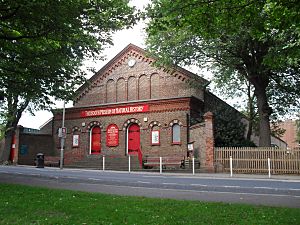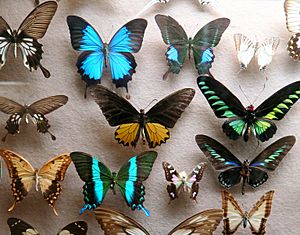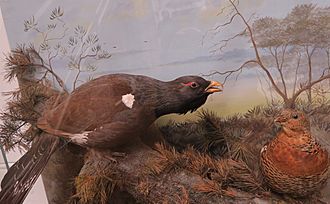Booth Museum of Natural History facts for kids

The museum from the southwest
|
|
| Lua error in Module:Location_map at line 420: attempt to index field 'wikibase' (a nil value). | |
| Established | 1874 |
|---|---|
| Location | 194 Dyke Road, Brighton, East Sussex, England BN1 5AA |
| Type | Natural history museum |
| Collection size | 500,000 (approx.) |
| Public transit access | Brighton railway station; Brighton & Hove Buses routes 14,14C,27 |
The Booth Museum of Natural History is a fantastic museum in Brighton, England. It's a place where you can explore the natural world. The museum is famous for its amazing collections from the Victorian era. You'll find many stuffed British birds, cool insects like butterflies, and ancient fossils. It also has skeletons and plant collections. The museum is managed by the "Royal Pavilion & Museums Trust" and it's completely free to visit!
Contents
History of the Booth Museum
How the Museum Started
The Booth Museum first opened its doors in 1874. It was created by a passionate naturalist and collector named Edward Thomas Booth. Edward Booth was especially interested in birds. His big dream was to collect an example of every single bird species found in Britain. He wanted to show a male, a female, a young bird, and any different feather patterns for each species.
Pioneering Diorama Displays
Edward Booth was a true pioneer in how he displayed his collections. He presented his birds in dioramas. These are like 3D scenes that try to show animals in their natural homes. For example, he described his gannet diorama as looking like the north side of the Bass Rock. His museum was the first in Britain to use these lifelike displays. This new way of showing animals influenced many other museums.
The Museum Becomes Public
In 1890, Edward Booth generously gave his museum to the city of Brighton. He had one special rule: the more than 300 bird dioramas should not be changed. The museum officially opened under Brighton's ownership in 1891. Later, in 1971, the Booth became known as a Museum of Natural History.
What You Can See Today
The museum still features those amazing dioramas of British birds. But it has grown a lot since then! Today, it also has huge collections of butterflies, British fossils, and animal bones. Over the years, many new items have been added. The museum now holds about 700,000 insects. It also has 73,000 specimens related to animals with backbones. This includes skeletons, stuffed animals, and bird eggs. There are 35,000 fossils and minerals, 60,000 plants, and 5,000 tiny slides for microscopes.
Other Important Collections
The museum also has collections from other famous collectors. One is the plant and rock collection from Sir Alexander Crichton. He was a chief doctor to the Russian Tsar from 1803 to 1819. He collected plants and rocks in his free time. Another amazing collection is of South and Central American butterflies. These were gathered by Arthur Hall during 13 trips to the Americas between 1901 and 1939. This collection fills over thirty cabinets! It even includes hundreds of "type specimens," which are the first examples used to describe a new species.
New Discoveries
In 2020, an unknown species of pterosaur (a flying reptile from dinosaur times) was found in the museum's fossil collection! This shows that museums can still hold exciting secrets.
Exploring the Exhibits
Bird and Animal Collections
The museum's collection of stuffed birds is one of the biggest in the country. You can see so many different kinds! The museum also has a large collection of skeletons from Fredrick W Lucas. These include bones from birds and mammals from all over the world. You can see skeletons of primates, dolphins, and even animals that are now extinct, like the dodo and the thylacine. The biggest skeleton on display is from an orca (killer whale). It was found on the beach in Brighton in 1935.
Fossils, Insects, and Curiosities
Besides birds and skeletons, you'll find many interesting fossils and minerals. The insect displays are amazing, with over 650 types of butterflies to admire. The museum also has some fun "Victorian curiosities." These include a fake merman and a "Toad in the Hole" display. These were popular oddities in the Victorian era.
Modern Connections
Some of the exhibits at the Booth Museum were used as references for the computer-generated images in the 2019 TV show His Dark Materials. This shows how old collections can inspire new creative works! In early 2024, the museum added a brand new diorama. It was the first new one in 92 years! This new display, called 'Life in the Garden', shows the wildlife found right here in the city.
See also
- Grade II listed buildings in Brighton and Hove: A–B



